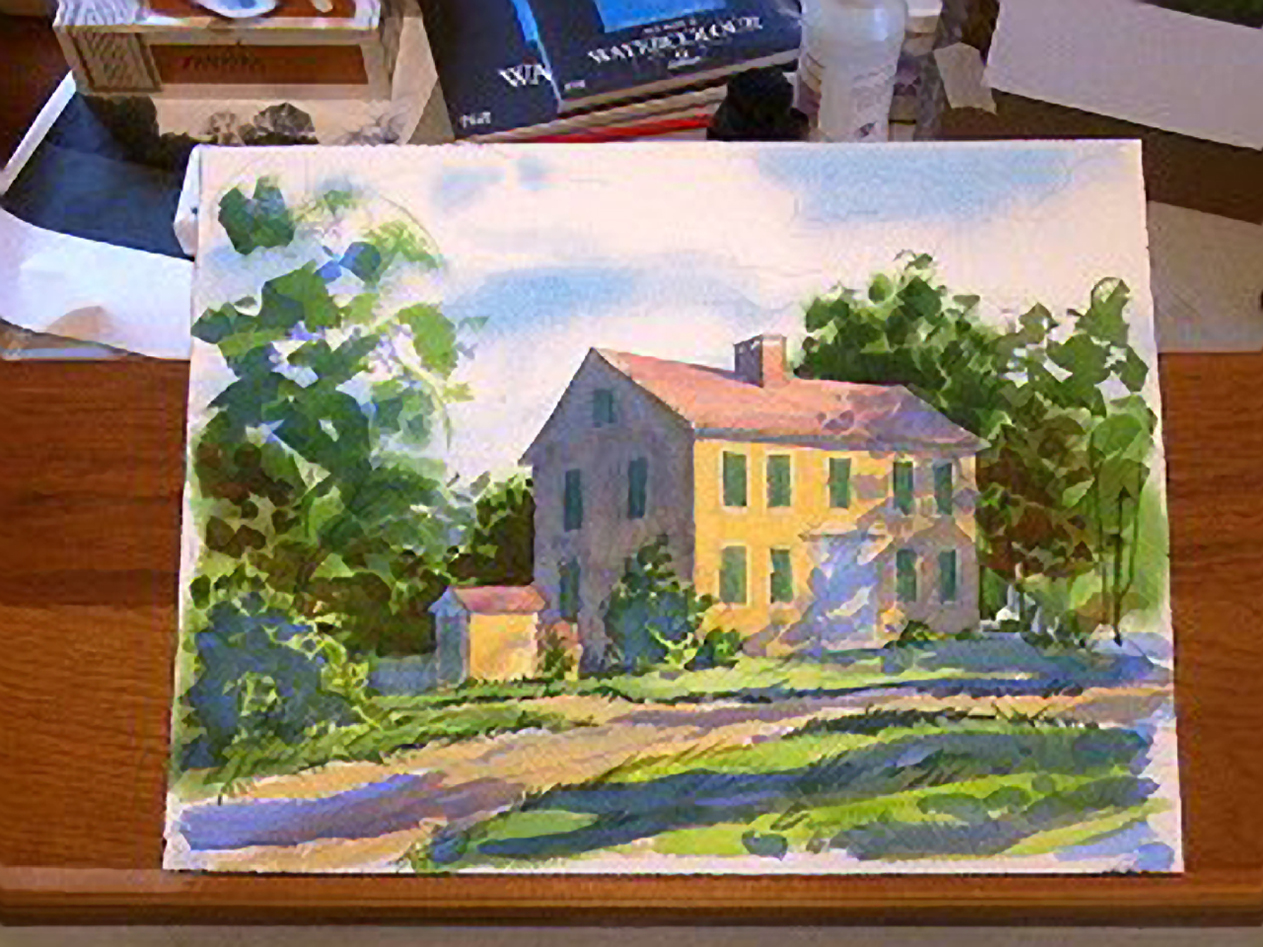Materials Used:
Brushes
- 1 1/2" (381mm) Flat Winsor & Newton Series 965
- 1" Grumbacher Aquarelle Flat Red Sable
- #12 Winsor & Newton Series 7 Red Sable
- #10 Winsor & Newton Series 820 Red Sable
- #6 Grumbacher Watercolor Classic Red Sable
Paints
- Sap Green
- Hooker's Green Dark
- Phthalocyanine Blue
- Cobalt Blue
- Dioxazine Purple
- Alizarin Crimson
- Permanent Rose
- Raw Sienna
- Burnt Umber
Paper
- Arches 140lb cold press watercolor block (size 12" x 16")
Miscellaneous
- #2 Pencil
- Kneaded Eraser
- Palette - Your choice. Mine is an old Robert E. Wood model.
- Water container (x2) filled with clean water
- Hair dryer (optional)
Step 1: Preliminary Drawing
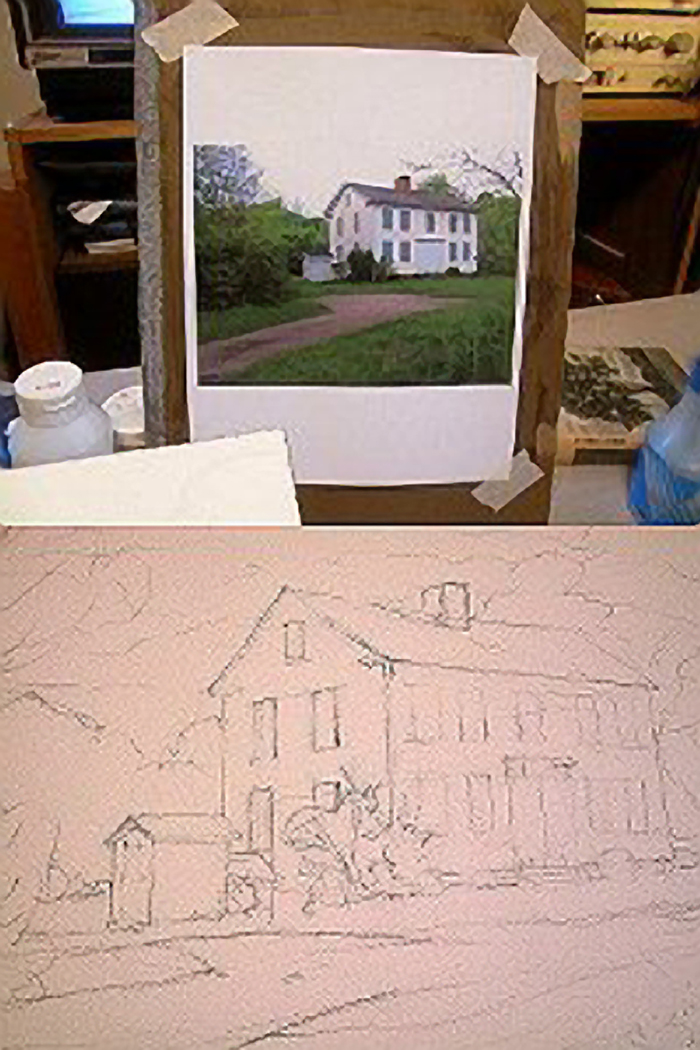 Take time and sketch your preliminary drawing. Architectural subjects demand a certain amount of understanding how the geometric shapes interconnect to make the whole pattern. Pictured here is the original photo, a rather gray day shot, and the initial sketch. More time was spent on the shape of the building and the loose arrangement of all the foliage. My plan of attack was to simulate a late evening light raking across the whole tableau coming in from the upper right.
Take time and sketch your preliminary drawing. Architectural subjects demand a certain amount of understanding how the geometric shapes interconnect to make the whole pattern. Pictured here is the original photo, a rather gray day shot, and the initial sketch. More time was spent on the shape of the building and the loose arrangement of all the foliage. My plan of attack was to simulate a late evening light raking across the whole tableau coming in from the upper right.
Step 2: First Washes
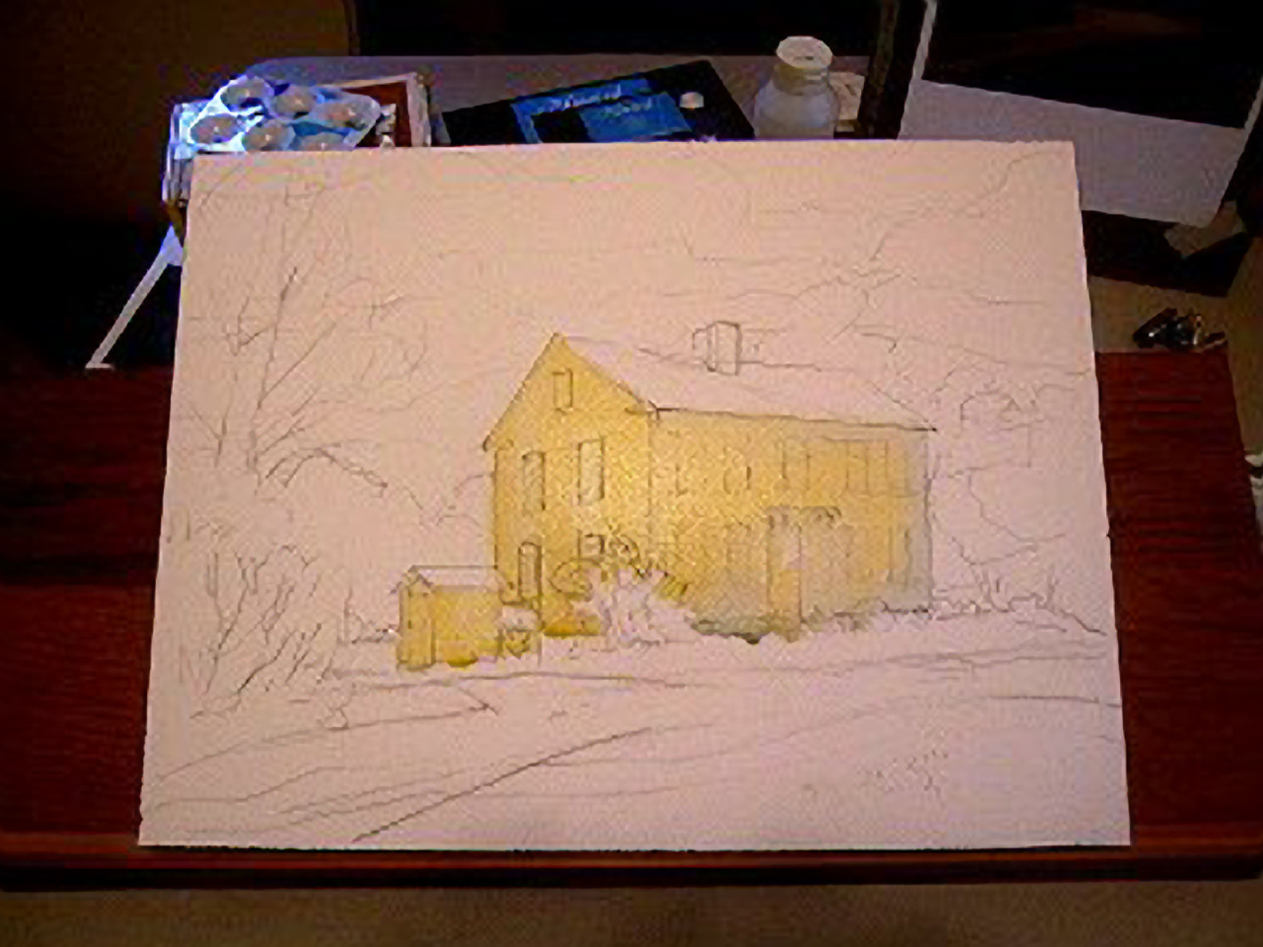 The original building is stark white, but I wanted to warm up the tone for the new lighting. To set the stage, I used a wash of raw sienna and pulled a wash gradation with a mix of cobalt blue and burnt umber for the area closer to the ground.
The original building is stark white, but I wanted to warm up the tone for the new lighting. To set the stage, I used a wash of raw sienna and pulled a wash gradation with a mix of cobalt blue and burnt umber for the area closer to the ground.
Step 3: Shadow Attack!
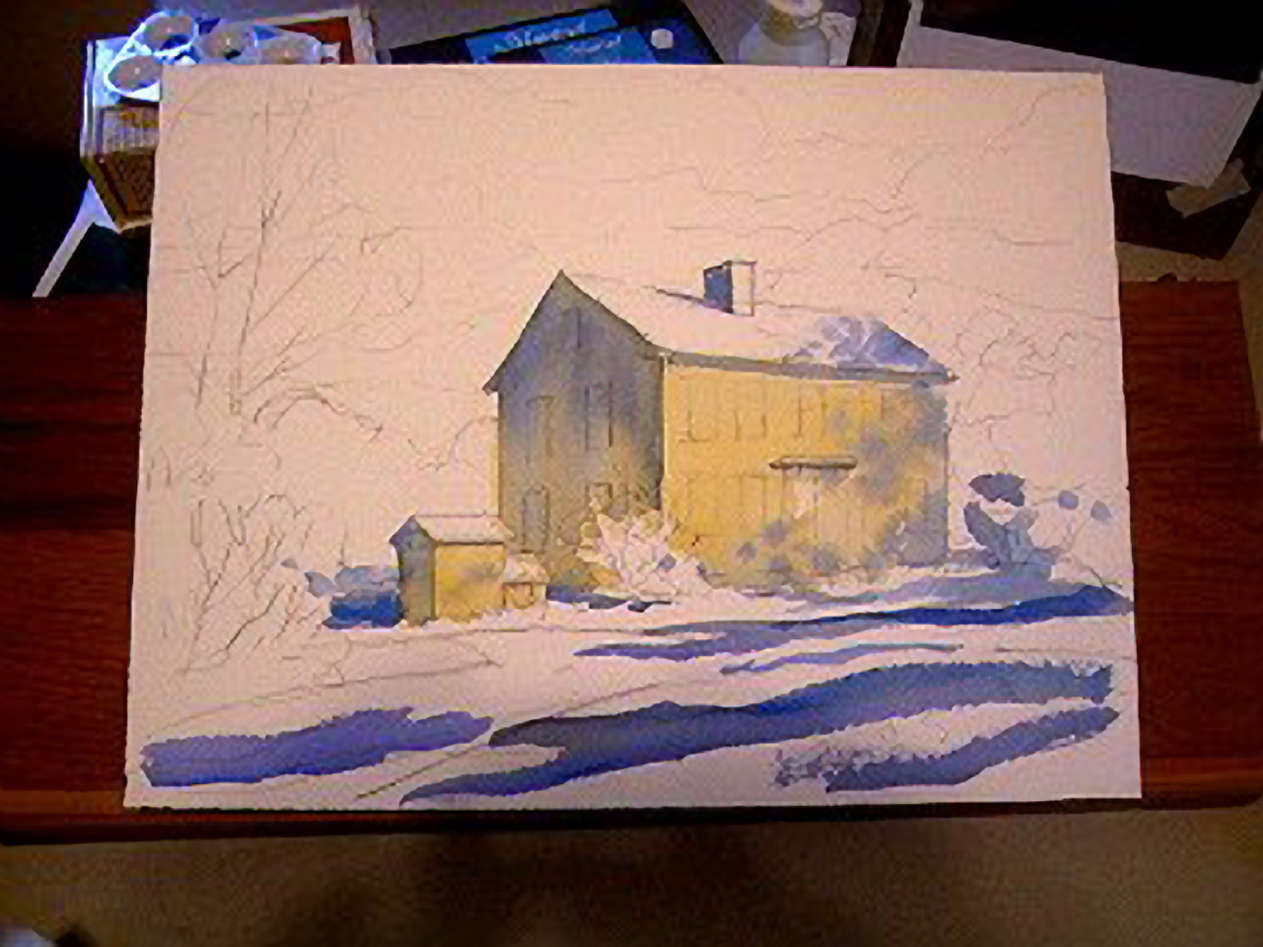 I moistened the top of the roof, and while the Raw Sienna wash was still damp, I added some shadows from the trees to right. When the house wash was dry enough, I added the shadow wash on the left of the house using Cobalt Blue grayed slightly with some of Burnt Umber. Trying to keep in mind the shapes of the woods and trees around the house, and the lighting direction, I laid down the basic shape and direction of the shadows in the foreground and mid-ground using a mix of Cobalt Blue and a bit of Dioxazine Purple on the left shadow areas across the path. Then I noticed the chimney, so I blocked that in with the same blue I used on the side of the house.
I moistened the top of the roof, and while the Raw Sienna wash was still damp, I added some shadows from the trees to right. When the house wash was dry enough, I added the shadow wash on the left of the house using Cobalt Blue grayed slightly with some of Burnt Umber. Trying to keep in mind the shapes of the woods and trees around the house, and the lighting direction, I laid down the basic shape and direction of the shadows in the foreground and mid-ground using a mix of Cobalt Blue and a bit of Dioxazine Purple on the left shadow areas across the path. Then I noticed the chimney, so I blocked that in with the same blue I used on the side of the house.
Step 4: Whoa! What's All This?
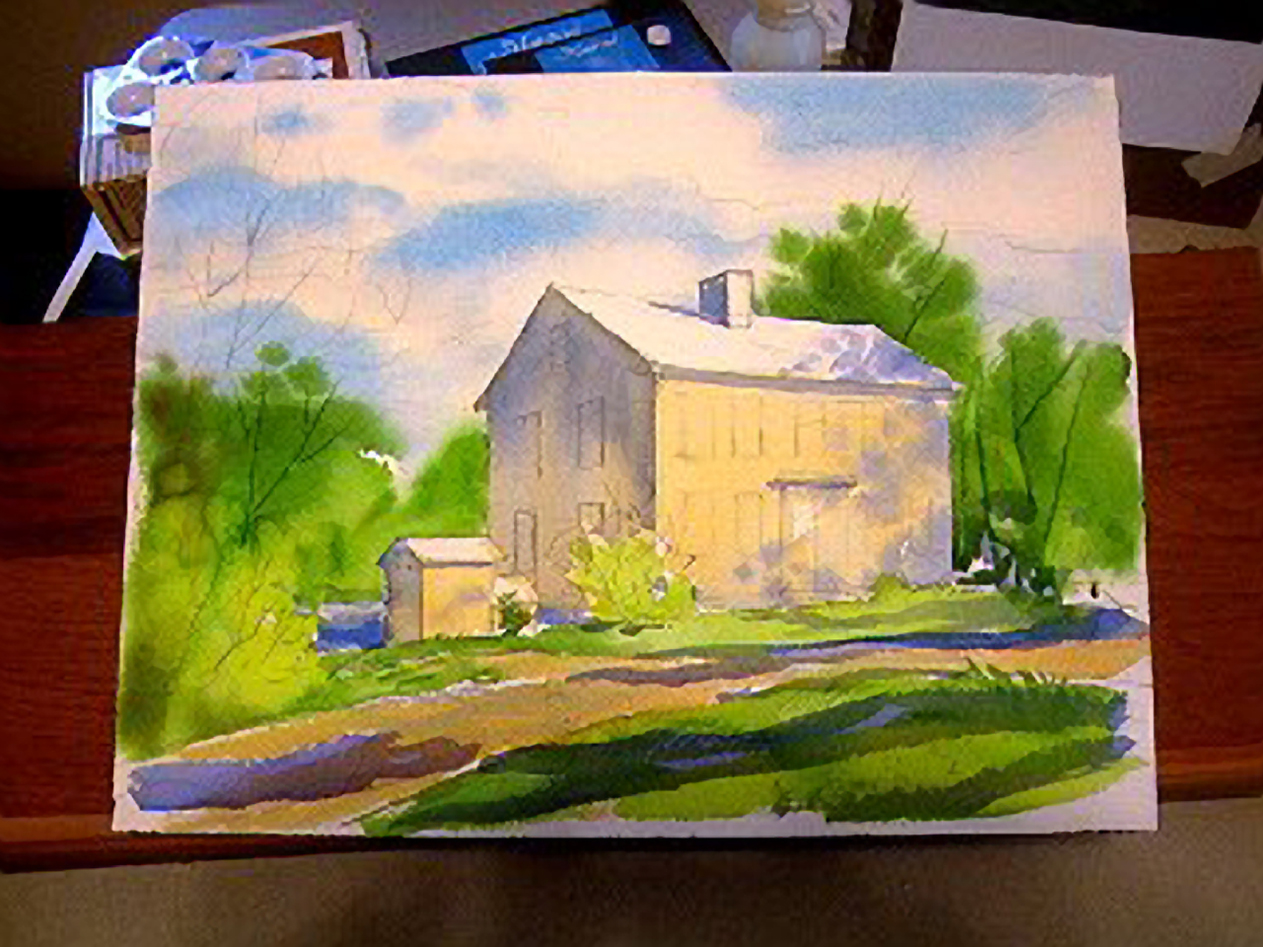 I moistened the entire sky area with a 1 1/2" wash brush and flicked in a few clouds in the sky using pure Cerulean Blue and a #12 round, a great color for classic Kodak-worthy skies. While the sky was still wet, I mixed up some Sap Green and some Cadmium Yellow Light (Lemon) and started blocking in all the green areas and shapes, allowing it to fuzz off in the distance a bit. I used a Raw Sienna wash in the exposed earth areas of the pathways. Over top of this, when dry, I dragged a 1/2" flat brush on its side to get the texture in the path.
I moistened the entire sky area with a 1 1/2" wash brush and flicked in a few clouds in the sky using pure Cerulean Blue and a #12 round, a great color for classic Kodak-worthy skies. While the sky was still wet, I mixed up some Sap Green and some Cadmium Yellow Light (Lemon) and started blocking in all the green areas and shapes, allowing it to fuzz off in the distance a bit. I used a Raw Sienna wash in the exposed earth areas of the pathways. Over top of this, when dry, I dragged a 1/2" flat brush on its side to get the texture in the path.
Step 5: Next?
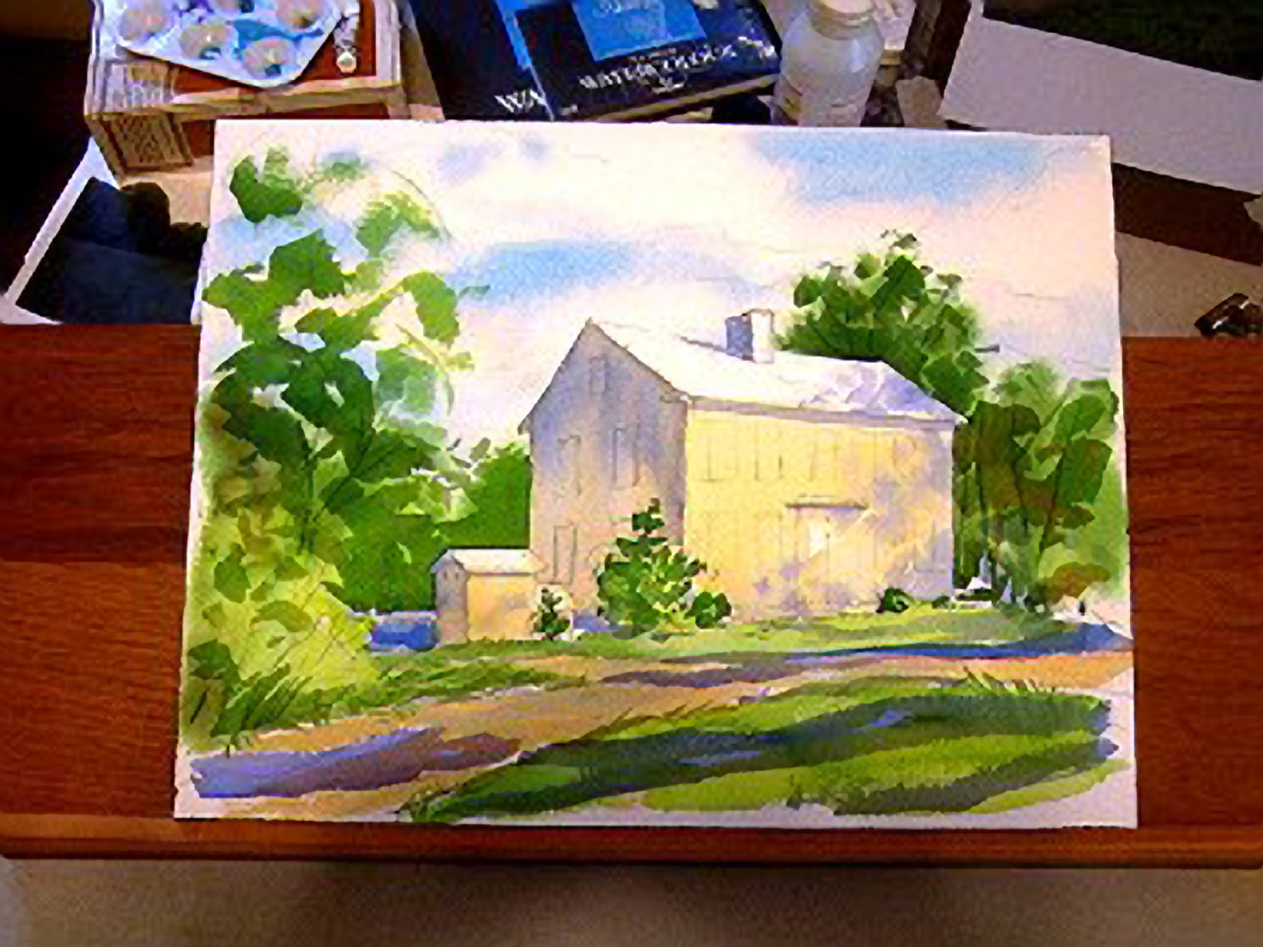 I dried the painting with my hair dryer, and, using more of a dry brush approach, I started drawing in the forms of the bushes and trees with a 1" flat sable. I used Sap and Hooker's Green Dark for the most part. I took care in the way the shapes of the tree foliage lay over the sky areas. Using various green values and shades from the puddles laying around, I used a #6 round sable and indicated some grass here and there.
I dried the painting with my hair dryer, and, using more of a dry brush approach, I started drawing in the forms of the bushes and trees with a 1" flat sable. I used Sap and Hooker's Green Dark for the most part. I took care in the way the shapes of the tree foliage lay over the sky areas. Using various green values and shades from the puddles laying around, I used a #6 round sable and indicated some grass here and there.
Step 6: Building a House
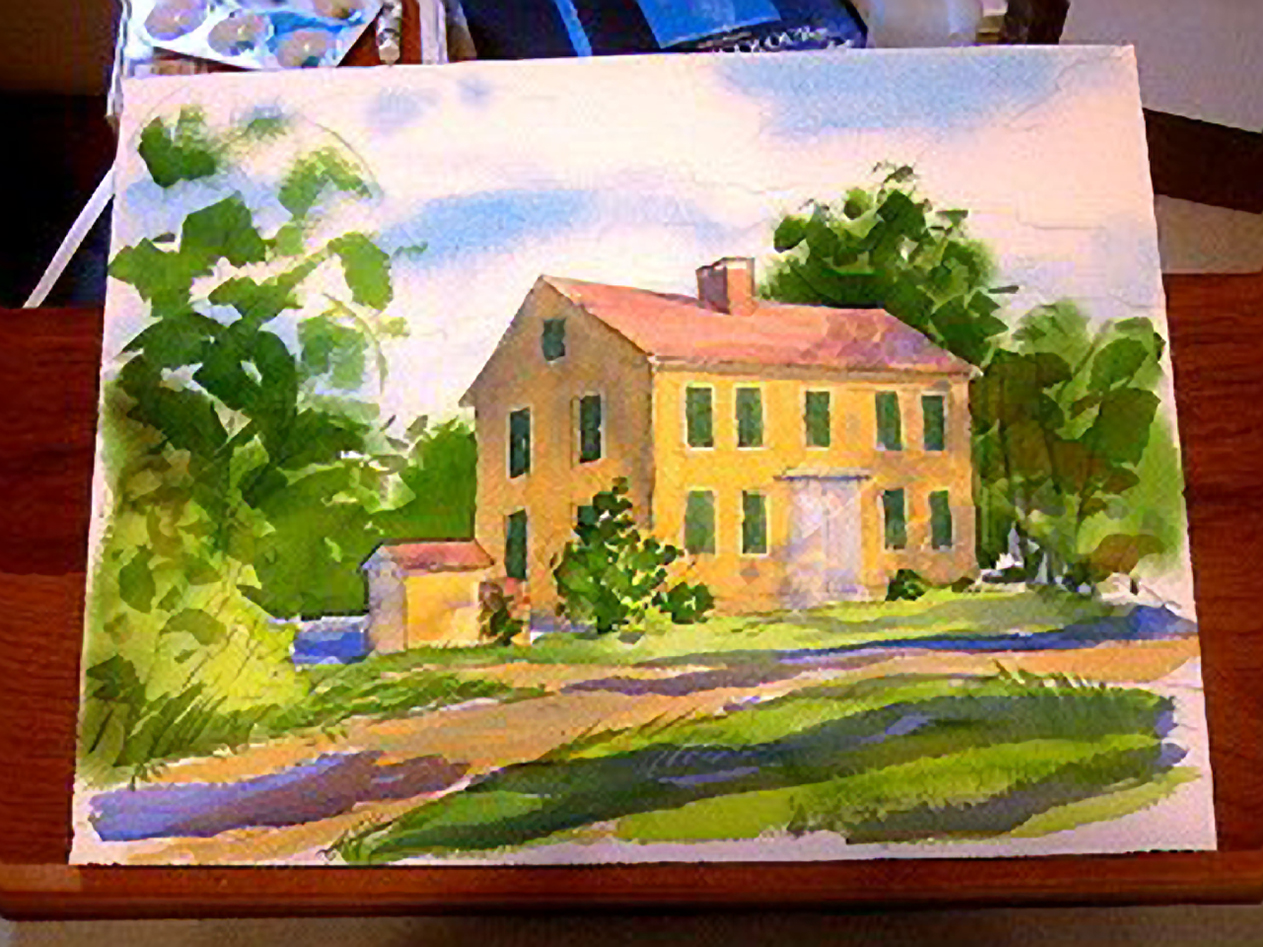 Using a mix of Permanent Rose, Burnt Sienna, and Cadmium Orange, I painted the local color on the roof. While that was damp, I used a purple mix to lay the shadows on the roof. I used the same purple and a touch of Cobalt Blue to add some details and shadows on the white front door area. With a mix of Sap Green and Raw Sienna, I painted the window shutters.
Using a mix of Permanent Rose, Burnt Sienna, and Cadmium Orange, I painted the local color on the roof. While that was damp, I used a purple mix to lay the shadows on the roof. I used the same purple and a touch of Cobalt Blue to add some details and shadows on the white front door area. With a mix of Sap Green and Raw Sienna, I painted the window shutters.
Step 7: Strengthen the Design
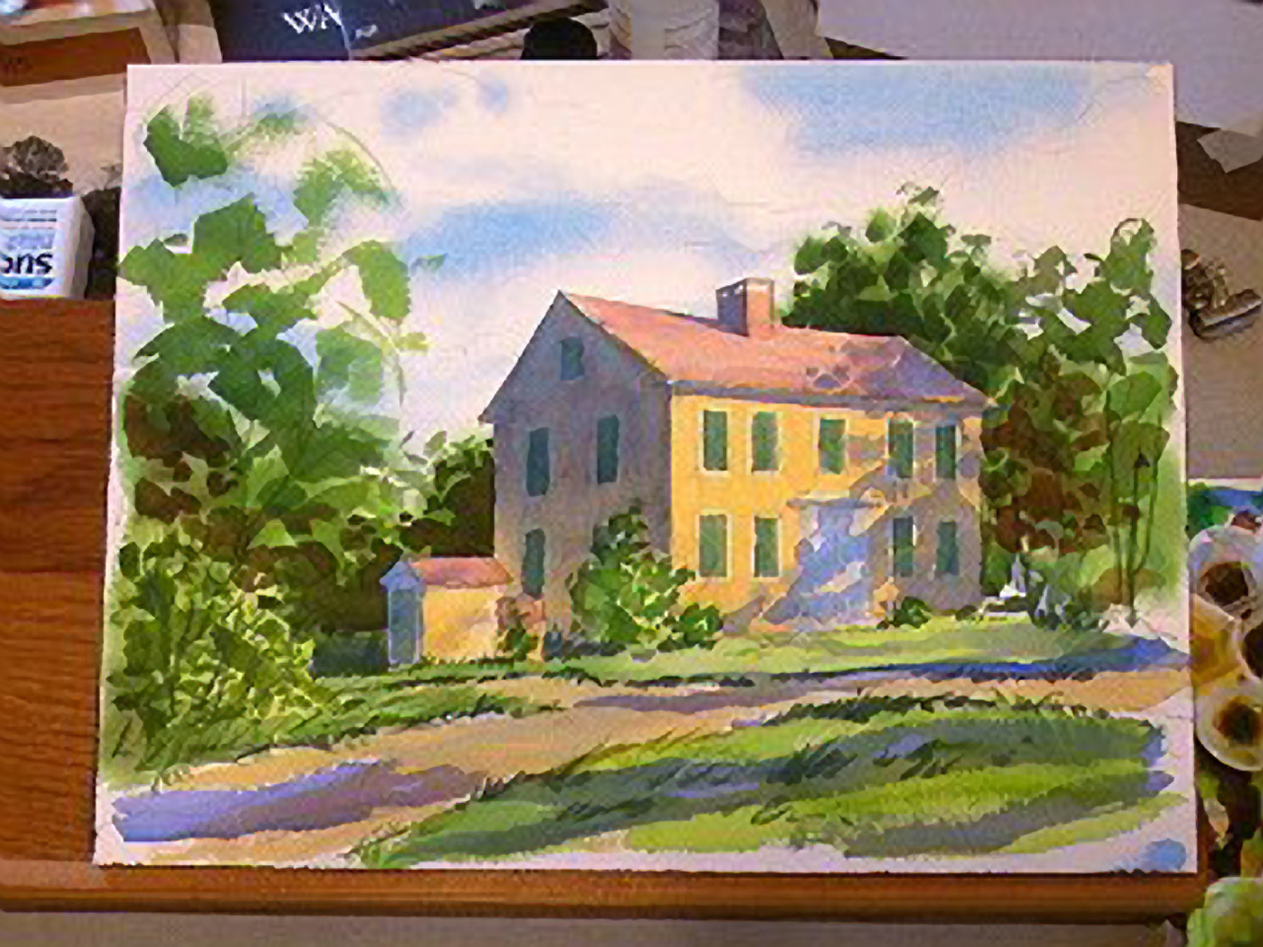 To add atmosphere and drama and to start pulling the painting together, I mixed a bit of Alizarin Crimson with Sap Green and deepened the tree line around the house. This helped pop the contrast with the side of the house in shadow. Then I mixed an intense Cobalt Blue wash and got bold with the patterns in the shadows of trees that fall across the house. Some Hooker's Green Dark and Burnt Umber were mixed and I added dark clumps of grasses across the foreground, playing with the overall patterns that have arisen as the painting progressed.
To add atmosphere and drama and to start pulling the painting together, I mixed a bit of Alizarin Crimson with Sap Green and deepened the tree line around the house. This helped pop the contrast with the side of the house in shadow. Then I mixed an intense Cobalt Blue wash and got bold with the patterns in the shadows of trees that fall across the house. Some Hooker's Green Dark and Burnt Umber were mixed and I added dark clumps of grasses across the foreground, playing with the overall patterns that have arisen as the painting progressed.
Step 8: Playing in Space
I grabbed the #10 round sable and dipped into the blue mix from the previous step, using it to tone down the ground foliage and trying to push it back in the distance while pushing the large front bush closer to the corner of the house. An additional blue wash was then laid over the side of the house to adjust the apparent depth.
Step 9: Bringing into Focus
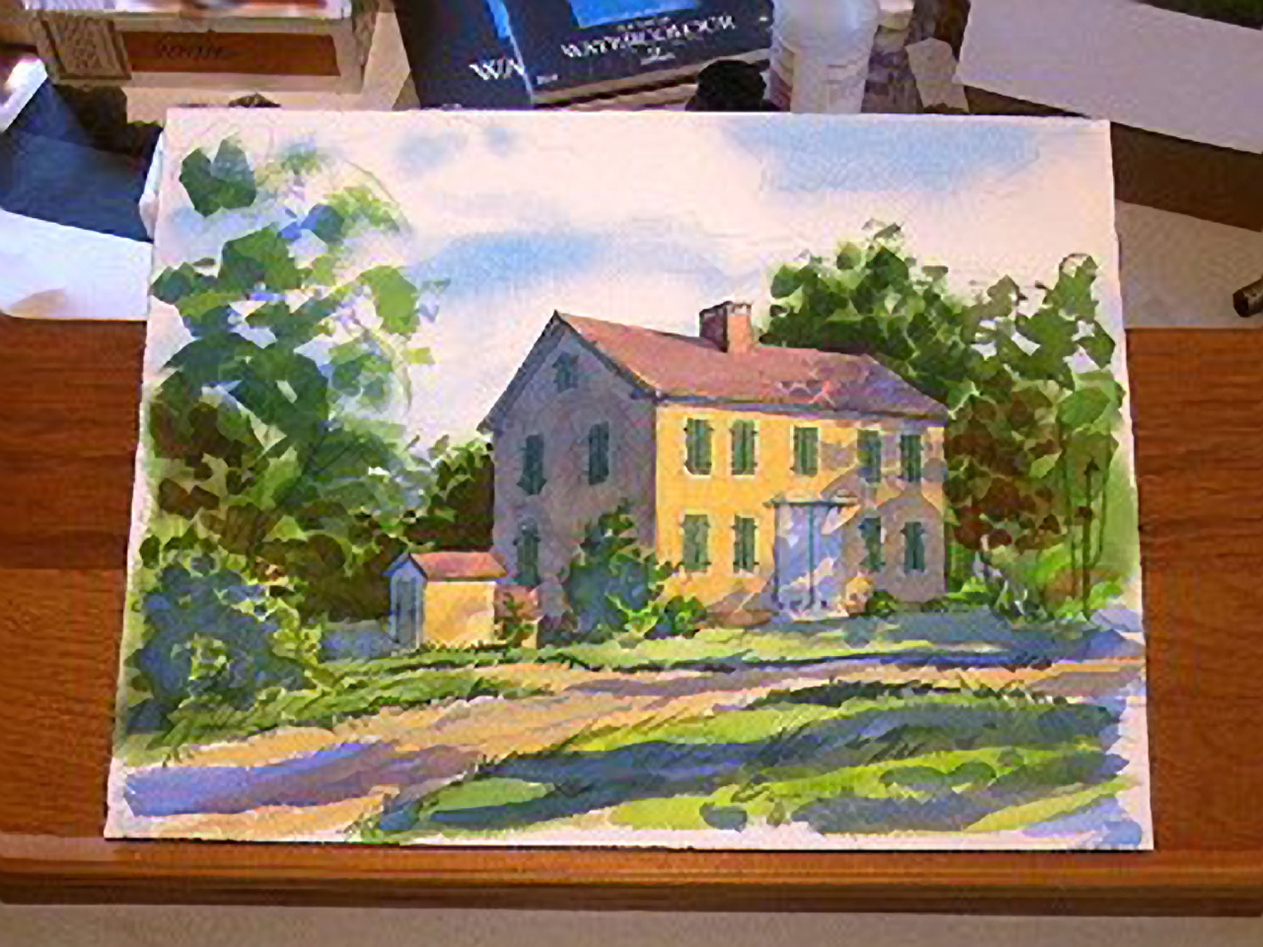 Using a #6 round sable, I used a Cobalt Blue, Burnt Umber, and Phthalocyanine Blue mix to add shutter details like the hinges and such. Mixing a darker green wash, I started indicating tree trunks and branches on the right side.
Using a #6 round sable, I used a Cobalt Blue, Burnt Umber, and Phthalocyanine Blue mix to add shutter details like the hinges and such. Mixing a darker green wash, I started indicating tree trunks and branches on the right side.
Step 10: All Done!
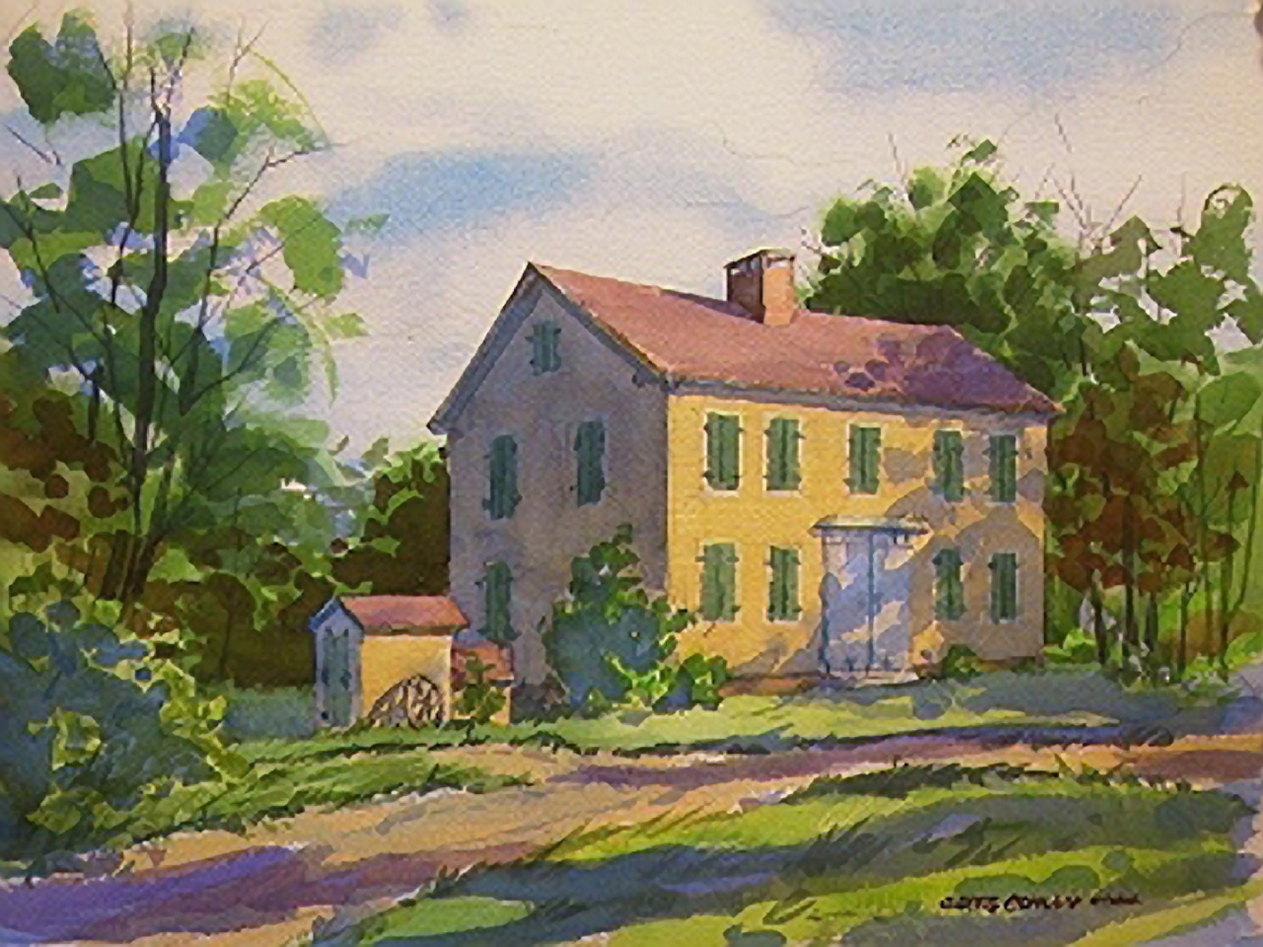 After letting the painting set out for a day, I brought it out again and looked at it with fresh eyes. I saw a few areas that needed tweaking, and after making some minor adjustments in contrast and shapes, the painting was declared finished.
After letting the painting set out for a day, I brought it out again and looked at it with fresh eyes. I saw a few areas that needed tweaking, and after making some minor adjustments in contrast and shapes, the painting was declared finished.
